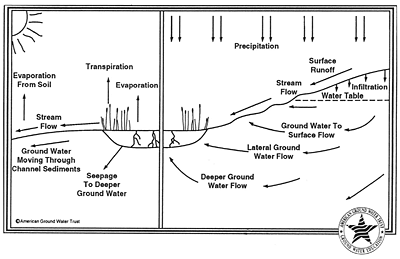
We all know groundwater occurs underground. We all know surface water, (ponds, lakes, rivers and wetlands) occurs at the surface. Surface water you can see, groundwater you can't see. What many people don't realize is much surface water was once groundwater. In some instances, what you see today as surface water may end up tomorrow as groundwater.
All water is part of the hydrologic system. Energy from the sun causes evaporation of water from the land, lakes, and oceans, which eventually falls as rain or snow. Once it reaches land, some water may move below ground, but eventually, virtually all of it will end up back at the surface. The figure below shows how water may move beneath the surface at different depths and travel at different speeds. Once water infiltrates below a depth where evaporation or plant roots can't reach, it may remain as groundwater for months, years, decades or even longer.
Have you ever wondered how rivers continue to flow even if it hasn't rained for weeks? The answer is groundwater, stored in rock formations, continues to supply water through banks and beds of rivers and streams. Once in the river, groundwater becomes surface water! In some cases, particularly in dry areas, rivers may lose water that soaks through the riverbed to reach groundwater. In these cases, surface water becomes groundwater!
In recent years we have become increasingly aware of the ecological importance of wetlands. Following the lead of federal agencies, most states have strict rules to protect wetlands. Nearly all America's freshwater wetlands are maintained because of inflow from groundwater. The close hydrologic connection between wetlands and groundwater is good reason for wetland biologists to understand groundwater and for groundwater specialists to appreciate ecological significance of wetlands. groundwater has great environmental, and economic significance. Protecting aquifers makes good ecological and economic sense.
A great way to help people understand how the hydrologic system works is to think about how one water drop may have moved through the hydrologic system. For example, from cloud to rain drop, then infiltration through the soil to groundwater, then slow travel through rock formations into a valley bottom wetland, then from the wetland into a river and back to the ocean. The process could take many years. The drop may have traveled a few miles, or hundreds of miles. During its travel it could have been intercepted by a water well and swirled up through the impellers of an irrigation pump and moved from groundwater to the surface in a few seconds.
The many ways water can move through the hydrologic system provide great opportunities for teaching. Your imagination is the only limitation to the way you can tell the story of the water drop; and in the process, help people understand the importance of protecting resources, and managing water use to be sustainable.
A copy of this article may be downloaded from the American Ground Water Trust's Website at agwt.org
Next month, the Trust's Ground Water Education Article #3 will show how geology influences the occurrence of springs, where spring water originates and how spring water is different from well water.

Report Abusive Comment